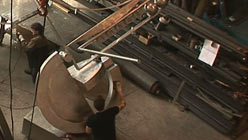Mel Ramos began making his mark on the art world in the early 1960s as part of the Pop Art movement exhibiting alongside artists like Andy Warhol, Claes Oldenburg, and Roy Lichtenstein. The imagery of Ramos’s work is borrowed from popular culture and mass media ranging from comic book heroes and celebrities to nude women provocatively posed with over-sized mass consumed products such as soda bottles, cigarette packs, and candy bars.
Ramos was born in Sacramento in 1935 into a Portuguese-American family. At his high school’s career day, he was introduced to painter Wayne Thiebaud, who became Ramos’s mentor for the next four years. Initially, Ramos had dreamt of becoming an abstract expressionist but decided that he “wasn’t depressed enough to be a good abstract expressionist” and wanted to do “something that’s fun.” As a result, his work is humorous and teeters between eroticism, camp and classic portraiture.
Ramos divides his time between Oakland, CA and Cataluna, Spain. He works in his studio every day and has been working on a new collection of work entitled “The Lost Paintings of 1965,” as well as a sculpture series based on his paintings of the female form with large-scale commercial objects. He is represented by Modernism in San Francisco and Louis K. Meisel Gallery in New York. Spark visits Ramos as he plans a retrospective of his work with at Modernism.
Resources
- Array
- Array
- Array
- Array

